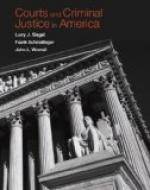On the other hand, where the weapon has not been spirited away the detectives may spend weeks in discovering when and where it was purchased. Every pawnshop, every store where a pistol could be bought, is investigated, and under proper circumstances the requisite evidence to show deliberation and premeditation may be secured.
These investigations are naturally conducted at the very outset of the preparation of the case.
The weapon, in seven trials out of ten, is the most important thing in it. By its means it can generally be demonstrated whether the shooting was accidental or intentional—and whether or not the killing was in self-defence.
Where this last plea is interposed it is usually made at once upon the arrest, the accused explaining to the police that he fired only to save his own life. In such a situation, where the killing is admitted, practically the entire preparation will centre upon the most minute tests to determine whether or not the shot was fired as the accused claims that it was. The writer can recall at least a dozen cases in his own experience where the story of the defendant, that the revolver was discharged in a hand-to-hand struggle, was conclusively disproved by experimenting with the weapon before the trial. There was one homicide in which a bullet perforated a felt cap and penetrated the forehead of the deceased. The defendant asserted that he was within three feet of his victim when he fired, and that the other was about to strike him with a bludgeon. A quantity of felt, of weight similar to that of the cap, was procured and the revolver discharged at it from varying distances. A microscopic examination showed that certain discolorations around the bullet-hole (claimed by the defence to be burns made by the powder) were, in fact, grease marks, and that the shot must have been fired from a distance of about fifteen feet. The defendant was convicted on his own story, supplemented by the evidence of the witness who made the tests.
The most obvious and first requirement is, as has been said, to find the direct witnesses to the facts surrounding the crime, commit their statements under oath to writing, so that they cannot later be denied or evaded, and make sure that these witnesses will not only hold no intercourse with the other side, but will be on hand when wanted. This last is not always an easy task, and various expedients often have to be resorted to, such as placing hostile witnesses under police surveillance, or in some cases in “houses of detention,” and hiding others in out-of-the-way places, or supplying them with a bodyguard if violence is to be anticipated. When the proper time comes the favorable witnesses must be duly drilled or coached, which does not imply anything improper, but means merely that they must be instructed how to deliver their testimony, what answers are expected to certain questions, and what facts it is intended to elicit




